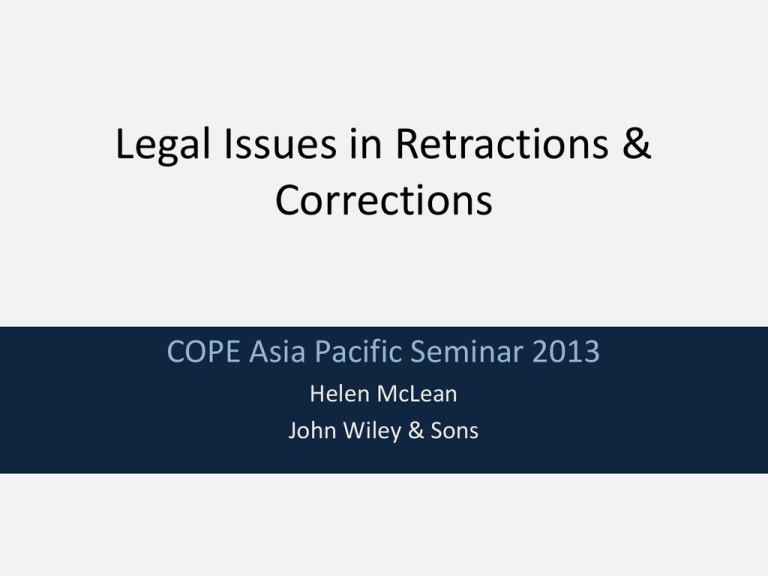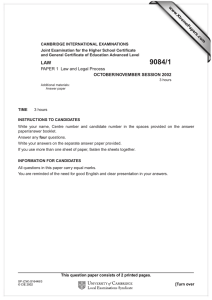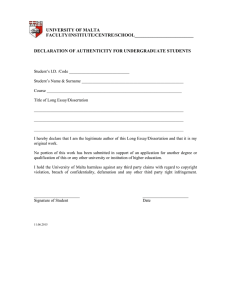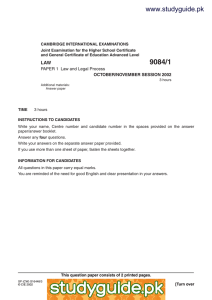presentation - Committee on Publication Ethics: COPE
advertisement

Legal Issues in Retractions & Corrections COPE Asia Pacific Seminar 2013 Helen McLean John Wiley & Sons Publication Ethics & the Law • • • • Overlap, but different issues & considerations Academic publishing is self policing Accepted “ethical practices” No legal status – Codes of Conduct & Best Practice Guidelines – COPE – Journal Policies Retractions, Corrections, Expressions of Concern • All can be appropriate methods of dealing with both ethical and legal issues • Retracted articles should generally NOT be removed from electronic archives or printed copies but their retracted status should be highlighted • Rare exceptions - removal for legal reasons e.g. court injunction, defamation, copyright infringement, breach of confidentiality Possible Legal Issues 1. Copyright infringement 2. Breach of confidentiality 3. Allegations of fraud/misrepresentation – Authorship issues – Conflict of interest 4. Defamation A Global Problem • Publication is rarely limited to a territory • No uniform global defamation or copyright laws • Which laws apply? – Eg. in Australia defamation can occur wherever an electronic publication is downloaded/viewed • Rely on international treaties and some general universal principles Copyright Infringement General characteristics of copyright • Arises automatically and belongs to the creator • Can be assigned or licensed in full or part • Protects the work from unauthorised reproduction, communication, distribution, adaptation, translation • Not a monopoly right – fair dealing (‘fair use’ in US), other exceptions • Protects the form of expression and not underlying idea or research Plagiarism vs Copyright Infringement Plagiarism Copyright Infringement Reuse of ideas, concepts, structure, data No infringement unless exact words, figures or images replicated Taking credit for others’ work May be exceptions – fair dealing/use, criticism and review Author of original work may seek retraction or erratum Legal right of copyright owner to claim for financial damages See also: Self plagiarism (dual publication) Breach of confidentiality • Patents – Inventors need to file an application within a defined period – ‘Prior art’ – publication is public disclosure • Confidential data – Breach of contract between researcher and data source Allegations of fraud/misrepresentation • Not always strong legal case • Legal basis - fraud/misrepresentation/breach of contract – Plagiarism – Conflict of interest – Authorship issues – Peer review or submission process misconduct (breach of contract?) Defamation • Can arise in both articles and retraction statements • General principles of defamation / libel – Material must have been published & individual identified – Statement must lower the reputation of the person; injures professional reputation – Some defences: truth/justification, honest opinion/comment – Time limited cause of action How do you respond? Same manner as all complaints: • Follow COPE guidelines & journal policies • Gather evidence • Communicate with all parties • Involve the institution if appropriate • Due process Correcting the literature • Informing author’s institution • Publication of a correction, expression of concern or retraction • Where necessary - formal removal of the article • Publish an editorial Legal risks of retractions • Defamation – Think carefully about wording of retraction – Balance with necessity to be clear about reasons for retraction • Breach of contract – When submitted to journal, policies visible – Act in accordance with policies Wording of retraction notice • Remember principles of defamation • Rely on investigations and cite evidence if available • Remember purpose of retractions – to correct the scientific literature not to punish misbehaving authors! • What if retraction is because of conduct of only some authors? – The notice should mention this – BUT joint authorship also means joint responsibility so it is not appropriate for authors to dissociate themselves entirely from a retracted article even if they were not directly responsible for any misconduct Example The scientific study carried out by Dr Jones was wholly invalid. vs The U.S. Office of Research Integrity (ORI) has expressed concerns over the validity of the study carried out by Dr Jones. (example from ALPSP Training/COPE Publications Ethics Course) Court cases… • Handful of cases involving journal publications (and most in the US) • Generally courts have been reluctant to intervene in cases that have involved authorship disputes or allegations of stolen data – Often found no legal grounds – Other more appropriate forums for airing of scientific disputes – Respect for scientific processes • Courts more likely to be involved with established causes of action – defamation, copyright infringement Balancing Act • Balance legal risks with the need to ensure prompt retractions – If dispute is not able to be resolved and parties will not agree as to course of action / wording of retraction statement • • • • Consider involving institution (if not already involved) Consider available evidence Obtain advice Act! Suggestions to Minimise Legal Risk • Have a good policy • Ensure this is available and communicated to authors • Follow processes in your policy / COPE Guidelines • Give an opportunity for all parties to respond • Seek agreement where possible



